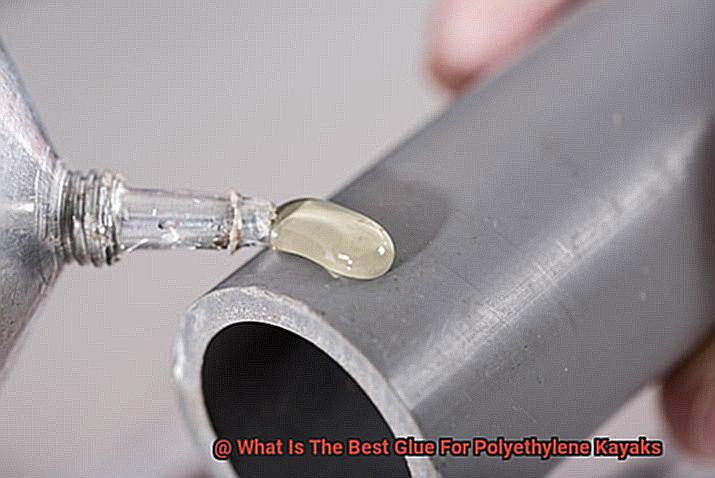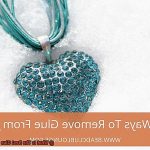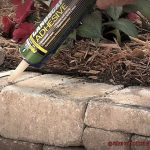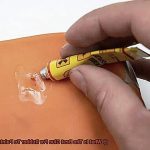Repairing your trusty polyethylene kayak is a task that requires the perfect adhesive. From pesky cracks to delamination problems, or simply reinforcing weak spots, choosing the right glue is absolutely crucial. In this comprehensive guide, we’ll dive into the world of glues and explore which ones are best suited for repairing polyethylene kayaks.
Polyethylene is a popular material in kayak manufacturing because it’s tough and flexible. But when it comes to bonding, its low surface energy can be quite the challenge. Thankfully, there are tried and tested glues out there that can handle this unique material.
First up, let’s talk about epoxy – a fan favorite. Epoxy is known for its rock-solid bonding strength and versatility, making it a reliable choice for polyethylene kayak repairs. It fills gaps like a pro and can withstand the harsh conditions of water exposure. Just keep in mind that epoxy takes its sweet time to cure properly and needs to be mixed correctly for optimal results.
Next on our list is polyethylene-specific adhesive, often labeled as “kayak repair adhesive” or “polyethylene glue.” These glues are specially designed to bond strongly with polyethylene surfaces. They set quickly and work like a charm with the material. However, do note that these glues may not have the same universal application as epoxy.
Last but not least, we have the hot air gun and polyethylene welding rod option – a technique commonly used by professionals in kayak repairs. Perfect for larger damages or joining separate parts together seamlessly, this method requires some serious skill and experience to execute correctly. By heating up the polyethylene surface and melting the welding rod onto it, you create an incredibly strong bond.
In your quest for finding the best glue for your polyethylene kayak, understanding each option’s advantages and disadvantages is key. Factors like bonding strength, drying time, and compatibility should be evaluated to confidently choose the adhesive that suits your repair needs.
Stay tuned as we dive deeper into each glue type, providing step-by-step breakdowns of the repair process and offering tips and tricks for a successful kayak restoration. With the right glue in hand, you’ll be gliding through the water in no time. So let’s get started.
What is Polyethylene?
Contents
- 1 What is Polyethylene?
- 2 Why Is Polyethylene Used in Kayaks?
- 3 Challenges of Bonding Polyethylene Kayaks
- 4 The Best Glue for Polyethylene Kayaks: Two-Part Epoxy Adhesive
- 5 Preparing the Surface for Optimal Adhesion
- 6 Specialized Polyethylene Adhesives
- 7 Alternative Bonding Methods
- 8 Considerations When Choosing the Best Glue for Polyethylene Kayaks
- 9 Conclusion
Polyethylene, a versatile plastic renowned for its adaptability and durability, has become an integral part of our everyday lives. From the packaging industry to outdoor furniture, this flexible material offers a plethora of applications. In this comprehensive exploration of polyethylene, we will delve into its significance when constructing kayaks and highlight its unique properties.
Understanding Polyethylene:
Polyethylene is a thermoplastic formed by polymerizing ethylene molecules derived from crude oil or natural gas. The resulting long chains of chemically bonded ethylene molecules give rise to various types of polyethylene, each possessing its distinct set of properties and applications.
Types of Polyethylene:
- Low-Density Polyethylene (LDPE): Known for its flexibility and toughness, LDPE is commonly used in packaging materials like plastic bags and shrink wrap. Additionally, it finds its way into household products such as squeeze bottles and toys.
- High-Density Polyethylene (HDPE): With higher density and strength compared to LDPE, HDPE is widely used in applications that require rigidity and durability. Water pipes, fuel tanks, and outdoor furniture often benefit from HDPE’s resilience.
- Ultra-High Molecular Weight Polyethylene (UHMWPE): This specialized form of polyethylene boasts an incredibly high molecular weight. UHMWPE exhibits exceptional resistance to wear and impact strength, making it ideal for demanding applications in aerospace, automotive, and medical industries.
Polyethylene Kayaks:
Polyethylene’s versatility extends to the realm of kayak construction. Repairing or bonding polyethylene kayaks can present a challenge due to the material’s unique properties. However, there are effective solutions available.
Adhesive Options:
One popular choice for repairing polyethylene kayaks is a two-part epoxy adhesive known for its remarkable bonding strength and durability. This adhesive forms a robust chemical bond with polyethylene, capable of withstanding water, heat, and environmental factors.
Surface Preparation:
To ensure optimal adhesion, proper surface preparation is essential before applying any adhesive. Polyethylene’s low surface energy makes it challenging for glues to stick. Consequently, cleaning the surface with mild detergent and roughening it with sandpaper or a wire brush creates a textured surface that enhances adhesive grip.
Alternative Bonding Methods:
Apart from epoxy adhesives, specialized polyethylene adhesives designed for bonding similar plastics are available. While these adhesives may not offer the same level of strength and durability as epoxy, they provide convenient application without extensive surface preparation.
Hot air welding and plastic welding are additional techniques for bonding polyethylene kayaks. These methods involve melting the surfaces together using heat or specialized plastic welding rods to create a strong bond.
Why Is Polyethylene Used in Kayaks?
Polyethylene, the MVP of kayak materials, is the go-to choice for kayak construction for several reasons. Let’s dive into the fascinating world of polyethylene and uncover why it’s the perfect material for kayaks.
First and foremost, polyethylene boasts an outstanding strength-to-weight ratio. It’s lightweight yet incredibly strong, allowing kayaks to handle anything thrown at them by Mother Nature – rocks, logs, and everything in between.
But it’s not just strength that makes polyethylene shine. Its durability is unparalleled, with impressive resistance to impacts and abrasion. No matter if you’re tackling white-water rapids or exploring rocky coastlines, your trusty polyethylene kayak will be right there with you, ready for any adventure.
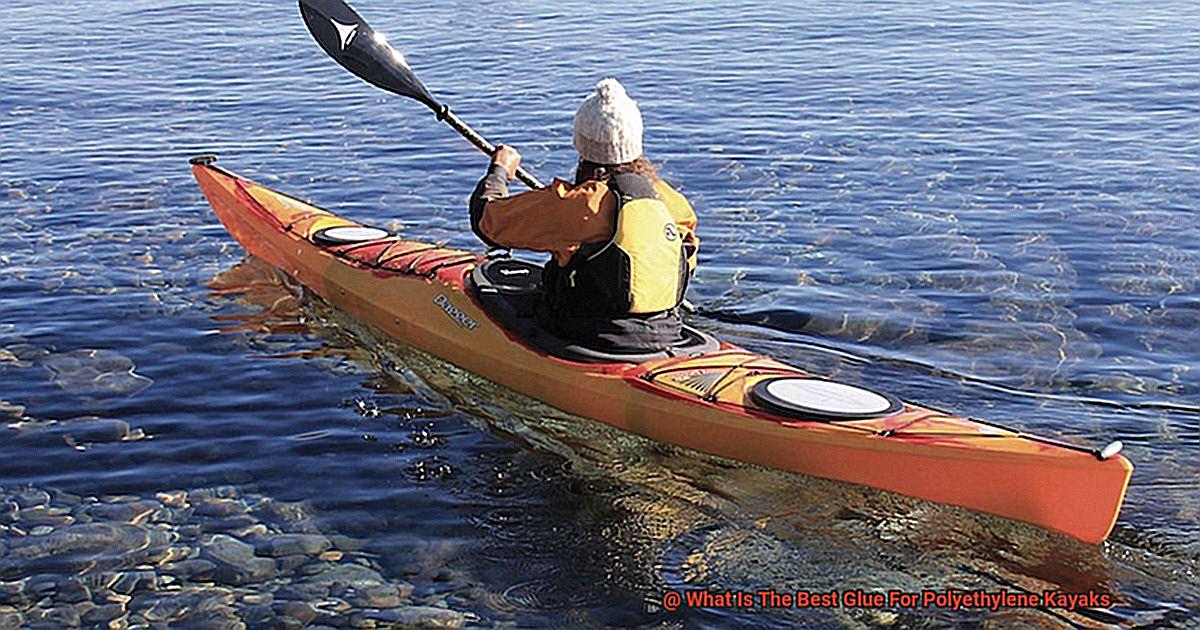
Buoyancy is another key benefit of polyethylene. Even if you’re not the strongest swimmer, you can rely on your kayak to keep you afloat. It’s like having a built-in safety net on the water, providing peace of mind for beginners or anyone looking to up their kayaking game.
Flexibility is an essential feature of polyethylene. Manufacturers can mold it into different shapes, creating a wide variety of kayak designs. Whether you prefer a sit-on-top kayak for easy access or a sleek touring kayak for long-distance paddling, polyethylene can do it all. Plus, its flexibility helps absorb impacts without cracking or breaking, making tight space navigation worry-free.

Let’s address the sun now. UV radiation can be damaging, but polyethylene is a superhero when it comes to UV resistance. Your kayak won’t fade or degrade easily when exposed to sunlight, ensuring it stays vibrant and strong for years to come.
Last but certainly not least, let’s talk cost. Polyethylene is a budget-friendly choice compared to other materials out there. It’s affordable without sacrificing quality, making it accessible to paddlers of all levels. So you can spend more time on the water and less time worrying about your wallet.
Challenges of Bonding Polyethylene Kayaks
Imagine gliding through calm waters, enveloped in the serenity of nature while navigating your trusty polyethylene kayak. Have you ever wondered about the construction process and the challenges faced by manufacturers when bonding polyethylene? Prepare to plunge into the world of kayak glue, my fellow water enthusiasts.
The Adhesive Conundrum:
Polyethylene’s low surface energy and non-porous nature pose a formidable challenge for traditional adhesives. Epoxy and super glue often struggle to form strong bonds with this material, leaving manufacturers perplexed and kayakers anxious about potential delamination.
Flexibility is Key:
Kayaks endure countless forces and movements in water, exerting stress on bonded areas. If the adhesive lacks flexibility, it may succumb to pressure, leaving you high and dry (or rather, wet and stranded).
Battling the Elements:
UV radiation, saltwater, and temperature fluctuations relentlessly test adhesives used in polyethylene kayaks. The chosen adhesive must bravely withstand these environmental adversaries while maintaining its bond strength over time.
Surface Preparation Matters:
Sloppily slapping glue onto polyethylene won’t cut it. Proper surface preparation is crucial. Thoroughly cleaning and roughening the surface enhance the adhesive’s ability to adhere. To boost bond strength, flame treatment or abrasion might even be required.
Beware of False Promises:
Not all adhesives marketed as suitable for polyethylene bonding deliver on their claims. Some boast effectiveness but crumble under scrutiny. Thus, meticulous research and testing are imperative to ensure your kayak remains securely bonded.
Seek Expert Advice:
When it comes to bonding polyethylene kayaks, wisdom lies in consulting experts or kayak manufacturers. They possess invaluable experience and knowledge to guide you in selecting the right adhesive and offer insights based on their expertise.
The Best Glue for Polyethylene Kayaks: Two-Part Epoxy Adhesive
When it comes to repairing your polyethylene kayak, you want a glue that can stand up to the elements and provide a lasting bond. That’s where two-part epoxy adhesive comes in. Here’s why it’s considered the best glue for polyethylene kayaks:
- Strong Bonding Strength: Polyethylene is notoriously difficult to bond due to its low surface energy. However, two-part epoxy adhesive is formulated to overcome this challenge. By mixing the resin and hardener together, a chemical reaction occurs, creating a strong and permanent bond between the surfaces being glued. This means you can trust that your repair will hold up even in rough waters.
- Durability: Polyethylene kayaks are exposed to harsh conditions like UV rays and saltwater, which can weaken adhesives over time. Two-part epoxy adhesive is known for its durability and resistance to these elements. It can withstand the rigors of outdoor use, ensuring that your repair stays intact for years to come.
- Versatility: Two-part epoxy adhesive is not only great for repairing cracks in your kayak, but it can also be used for sealing leaks and securing attachments such as handles or fittings. Its versatility makes it a valuable tool for any kayak enthusiast.
- Proper Preparation: To ensure a successful bond, it’s important to properly prepare the surfaces before applying the adhesive. This involves cleaning the area thoroughly and roughening it with sandpaper to improve adhesion. Following these steps will help maximize the effectiveness of the epoxy adhesive.
- Curing Time: Two-part epoxy adhesive typically has a longer curing time compared to other glues, but this is actually an advantage when it comes to bonding polyethylene. The extended curing time allows for better bonding and ensures that the repair is strong and durable.
Remember, while two-part epoxy adhesive is highly effective for most repairs on polyethylene kayaks, it may not be suitable for all types of damage. For larger cracks or structural damage, welding or heat fusion techniques may be necessary. Always test the adhesive on a small area before applying it to the actual repair to ensure compatibility and proper bonding.
Preparing the Surface for Optimal Adhesion
When it comes to achieving a strong and long-lasting bond, preparing the surface is key. Whether you’re patching up cracks, sealing leaks, or securing attachments, proper surface preparation is vital for optimal adhesion. In this comprehensive guide, we will walk you through the essential steps to ensure a successful bond. So let’s dive in and discover how to prepare surfaces like a pro.
Step 1: Thoroughly Clean the Surface
Start by removing any dirt, dust, or grease from the surface. Use a mild detergent or specialized cleaner and gently scrub with a soft brush or cloth. This will create a clean and smooth surface, free from any contaminants that could hinder adhesion.
Step 2: Roughen Up the Surface
Smooth surfaces can pose a challenge for adhesives. To create a better bonding surface, lightly sand the area using fine-grit sandpaper. Sand in a circular motion to create tiny grooves and scratches that enhance the adhesive’s grip.
Step 3: Remove Sanding Residue
After sanding, wipe down the surface with a clean cloth or use compressed air to blow away any loose particles. A debris-free surface is crucial for optimal adhesion.
Step 4: Apply a Primer or Adhesion Promoter
Consider using a primer or adhesion promoter specifically designed for the material you are working with. These products improve bonding strength. Apply them according to the manufacturer’s instructions, ensuring full coverage of the bonding area.
Step 5: Allow Drying Time
Give the primer or adhesion promoter enough time to dry completely before applying the adhesive. Following the recommended drying time ensures optimal bonding strength.
Step 6: Choose the Right Adhesive
Select an adhesive that is compatible with your materials and provides excellent bonding strength. Consider factors such as environmental conditions and desired durability. Follow the manufacturer’s instructions, including any necessary mixing or layering requirements.
Step 7: Apply and Cure the Adhesive
Apply the adhesive according to the manufacturer’s instructions, ensuring proper coverage of the surfaces to be bonded. Press the surfaces firmly together and hold them in place for the recommended curing time. Avoid any movement or stress on the bonded area during this period.
Specialized Polyethylene Adhesives
Fear not, my fellow adventurers, for I am about to reveal the secret to repairing your polyethylene kayak – specialized polyethylene adhesives.
Regular adhesives simply won’t do the trick when it comes to repairing polyethylene. That’s where specialized polyethylene adhesives come into play. These remarkable substances are like superheroes for your kayak repairs, forming an unbreakable bond with polyethylene to ensure your repairs are strong and long-lasting.
Let’s explore the two main types of specialized polyethylene adhesives that will blow your mind. First up, we have the two-part epoxy adhesive. This dynamic duo consists of a resin and hardener that you mix together before applying to your kayak. Once it sets, it forms a chemical bond with the polyethylene that is practically indestructible. It’s like having a superhero on your side, fighting off any damage that comes your way.
But wait, there’s more. Another option is the polyethylene welding rod. Just imagine a solid rod that you heat up and melt onto the damaged area of your kayak. As it cools and solidifies, it creates a bond with the polyethylene that can withstand even the roughest waters. It’s like magic unfolding before your eyes.
Now, before you embark on your repair mission, let me provide you with some invaluable advice. Follow the instructions from the adhesive manufacturer meticulously. Prepare the surface by cleaning it thoroughly and roughening it up with sandpaper – this will ensure the adhesive sticks like glue (pun intended). And perhaps most importantly, be patient. Give the adhesive enough time to dry and bond properly, so your repair truly stands the test of time.
Alternative Bonding Methods
When it comes to bonding polyethylene kayaks, traditional glues just won’t cut it. But fear not. In this article, we will explore alternative bonding methods that will have your kayak back in action in no time. From heat welding to specialized adhesives, we’ve got the solutions you need.
- Heat Welding: Imagine a superhero duo fusing together to create an unstoppable force. That’s exactly what happens when you use heat welding on your polyethylene kayak. By using a specialized tool that generates heat, the polyethylene surfaces are melted together, creating a strong and long-lasting bond. It’s like a mini science experiment happening before your eyes.
- Specialized Adhesives: Not all glues are created equal, but there are adhesives designed specifically for polyethylene bonding. These magical adhesives chemically bond with the surface of the polyethylene, creating a connection as strong as Thor’s hammer. Just make sure to choose an adhesive formulated for polyethylene to ensure a successful bond.
- Two-Part Epoxy Adhesive: If you’re looking for a bonding method that packs a punch, look no further than two-part epoxy adhesive. This adhesive has excellent bonding properties and can create a bond tougher than Superman’s cape. However, be sure to select an epoxy that is suitable for polyethylene bonding to avoid any weak links in your kayak repair team.
- Specialized Bonding Kits: For an all-in-one solution, some manufacturers offer specialized polyethylene bonding kits. These kits are like having a sidekick guiding you through the entire bonding process. They often include adhesives, surface preparation materials, and easy-to-follow instructions – everything you need to save the day.
Remember, always follow the manufacturer’s instructions carefully and properly prepare the surface before bonding. Attention to detail is key, just like Batman meticulously planning his next move. Additionally, it’s essential to test your chosen method on a small, inconspicuous area before diving into larger repairs or bonding projects. Better safe than sorry.
Considerations When Choosing the Best Glue for Polyethylene Kayaks
Repairing a polyethylene kayak can be a daunting task, as finding the right glue that effectively bonds to this durable material is crucial. In this blog post, we will explore the important factors to consider when selecting the best glue for polyethylene kayaks. So grab your cape and get ready to unleash the power of adhesion.
Compatibility is key:
Polyethylene’s low surface energy makes it challenging for traditional glues to adhere properly. Look for glues labeled as compatible with polyethylene, formulated with special adhesion promoters or primers to enhance bonding properties.
Strength to withstand the elements:
Kayaks face constant exposure to water, UV radiation, chemicals, and temperature fluctuations. Choose a glue offering high tensile strength and resistance to these elements. Repairs must stand up to harsh conditions encountered during kayaking adventures.
Ease of application:
Opt for glues with straightforward instructions and minimal surface preparation requirements. Spend more time on the water and less time preparing surfaces or mixing complex ratios. This convenience is especially valuable for beginners.
Time is of the essence:
Consider the drying time of the glue. If you’re in a hurry, choose a fast-drying option. However, faster drying glues may have shorter working times, so follow instructions and work efficiently.
Seek wisdom from experienced kayakers:
Read reviews and seek recommendations from fellow kayakers or professionals who have successfully repaired polyethylene kayaks. Their insights provide valuable information on different glues’ performance and reliability.
sooI6QZCBH0″ >
Conclusion
In conclusion, finding the best glue for polyethylene kayaks can be a challenging task.
However, with careful research and consideration, there are a few options that stand out. One such option is the 3M Marine Adhesive/Sealant 5200, which is known for its strong bond and durability.
Another reliable choice is the Weld-On 16 Acrylic Cement, specifically designed for bonding polyethylene materials. Additionally, the G/flex Epoxy from West System is highly recommended for its flexibility and resistance to water.
It’s crucial to ensure that the glue you choose is compatible with polyethylene and can withstand exposure to water and UV rays.

